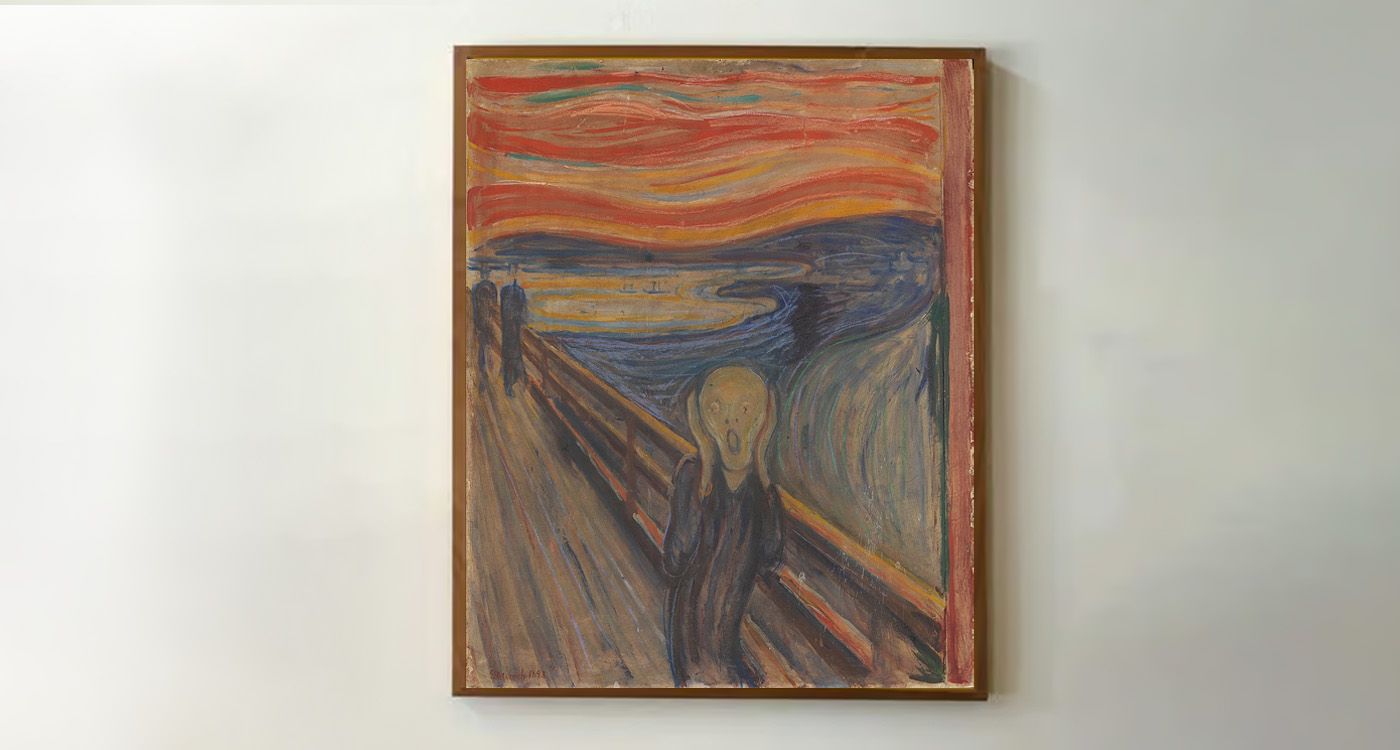
Stolen twice under circumstances worthy of a crime thriller, The Scream, the most anguished painting of the 20th century has led a life as tormented as its creator.
It is without a doubt one of the most recognizable paintings in the world: a pale face frozen in a silent scream, hands pressed against its cheeks, a burning red sky above a Norwegian fjord. Since its creation in 1893, The Scream by Edvard Munch has been the subject of endless interpretations, reproductions, and obsessions. A symbol of modern anxiety, a totem of expressionism, and a viral image before the digital age, the painting has also become a coveted fetish—so much so that, in a rare twist for such a famous work, it has been stolen twice in circumstances that seem straight out of a noir novel. Between bold heists, tragic amateurism, and chases worthy of a Hitchcock film, the fate of The Scream mirrors the paranoid loop depicted in the painting itself.
The first theft took place on February 12, 1994, in the heart of Oslo, at Norway’s National Gallery. That day, the city was preparing to open the Winter Olympics in Lillehammer. Media attention was elsewhere. The thieves took advantage of the distraction. At dawn, two masked men broke a window, disabled the meager alarm system, and seized the painting in under a minute. They left behind a mocking note: “Thanks for the poor security.” The masterpiece had vanished. The museum was in shock. So was the art world.
Norwegian police launched a massive investigation with no immediate results. Only after months of discreet work—and with help from undercover British agents—was the painting recovered in May 1994, in a seaside cabin, intact but slightly damaged. It had been used as currency in criminal circles linked to drug trafficking. The mastermind, Pål Enger, a former footballer turned art thief, was arrested. He later confessed that he targeted The Scream out of love for art—but also for glory. The story made headlines. Yet it was far from over.
Ten years later, on August 22, 2004, The Scream was stolen again. This time, it was a different version of the painting—Munch had created several—on display at the Munch Museum in Oslo. It was 11:15 AM, broad daylight. Two masked men burst into the gallery, threatened visitors and guards with firearms, and took The Scream along with another Munch masterpiece, Madonna, before fleeing by car, leaving chaos and panic in their wake.
The theft was violent, spectacular, almost theatrical. Surveillance footage showed terrified visitors, screams, children crying. International media seized on the story. It was called the theft of the century. Despite the museum’s modern security systems, it was heavily criticized for its slow response and the lack of direct protection for the artworks.
The investigation lasted two years. It involved wiretapping, surveillance, and infiltration of Norwegian criminal networks. In 2006, police managed to locate the stolen works, which were found in an alarming state. The Scream had been creased, scratched, with a tear running across the canvas. Madonna had suffered damage as well. But both paintings were restorable. Several individuals were convicted, including Bjorn Hoen, an Oslo crime boss suspected of organizing the theft to exert pressure in another legal case. The exact motives remain unclear—ransom, ego, or criminal confusion.
These two dramatic heists give The Scream a unique status in art history. Few paintings have been held hostage twice, in such different contexts. But perhaps that’s no coincidence. The Scream is the ultimate image of existential anguish. It’s instantly recognizable. Munch himself wrote in his journal: “I felt a great unending scream piercing through nature.” The spectral-faced figure is not screaming—it hears the scream. And so do we.
This immediate emotional impact makes it an ideal target: easily identifiable, hard to sell, but charged with immense symbolic power. The thieves knew it. The very image of fear, doubt, human fragility. As if, by ripping it from the museum wall, they wanted to pause that silent scream for a moment—keep it for themselves. Or rid themselves of it, unable to bear its reflection.
The painting’s turbulent life mirrors that of its creator. Deeply affected by the death of his mother and sister in childhood, Edvard Munch struggled all his life with anxiety, loneliness, and depression. He was fascinated by mental illness, which he saw as part of the artistic experience. His entire body of work is haunted by themes of loss, unattainable love, and melancholy. The Scream is a visual expression of this inner torment—one that became the silent cry of millions of men and women.
Today, The Scream is protected behind bulletproof glass in a climate-controlled room at the Munch Museum in Oslo. Visitors flock to see the painting, so famous it has become a pop icon—parodied, repurposed, printed on mugs. Yet despite all the media exposure, something endures. The character’s gaze, the twisted mouth, the burning sky behind—it all still unsettles us, still makes us wonder.
And maybe that’s what the thieves sensed, even if they couldn’t put it into words. That by taking The Scream, they were seizing hold of a raw emotion—impossible to silence. An image that, even when stolen, keeps screaming. A work that transcends time, like a whisper of our own disquiet.


Comments